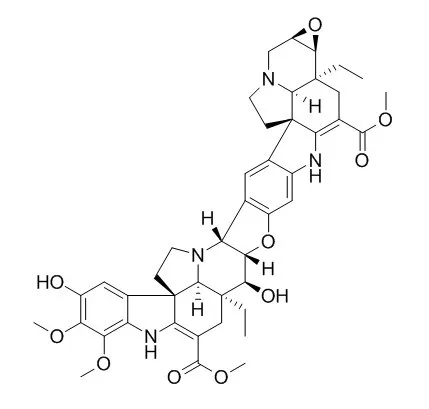| In vitro: |
| J. Integr. Agr., 2013, 12(4):678-86. | | Conophylline Promotes the Proliferation of Immortalized Mesenchymal Stem Cells Derived from Fetal Porcine Pancreas (iPMSCs)[Reference: WebLink] |
Conophylline, is a bis (indole) alkaloid consisting of two pentacyclic aspidosperma skeletons, isolated from Tabernaemontana divaricata, which has been found to induce b-cell differentiation in rat pancreatic acinar carcinoma cells and in cultured rat pancreatic tissue.
METHODS AND RESULTS:
We found that Conophylline can robustly stimulate iPMSCs proliferation, even promote their potential differentiation into islet-like clusters analyzed by cell counting, morphology, RT-PCR and real-time PCR, Western blotting, glucose-stimulated insulin release and insulin content analysis. The effects of Conophylline were inhibited by LY294002, which is the inhibitor of the PI3K pathway.
CONCLUSIONS:
These results suggest that Conophylline plays a key role in the regulation of cell mass proliferation, maintenance of the undifferentiated state of iPMSCs and also promotes iPMSCs differentiated into insulin-producing cells. | | Int J Biochem Cell Biol. 2006;38(5-6):923-30. | | Conophylline: a novel differentiation inducer for pancreatic beta cells.[Pubmed: 16337165 ] |
METHODS AND RESULTS:
Among various compounds and extracts tested, we found that Conophylline, a vinca alkaloid extracted from leaves of a tropical plant Ervatamia microphylla, was effective in converting AR42J into endocrine cells. Conophylline reproduces the differentiation-inducing activity of activin A. Unlike activin A, however, Conophylline does not induce apoptosis.
To induce differentiation of AR42J cells, Conophylline increases the expression of neurogenin-3 by activating p38 mitogen-activated protein kinase. Conophylline also induces differentiation in cultured pancreatic progenitor cells obtained from fetal and neonatal rats. More importantly, Conophylline is effective in reversing hyperglycemia in neonatal streptozotocin-treated rats, and both the insulin content and the beta cell mass are increased by Conophylline. Histologically, Conophylline increases the numbers of ductal cells positive for pancreatic-duodenal-homeobox protein-1 and islet-like cell clusters.
CONCLUSIONS:
Conophylline and related compounds are useful in inducing differentiation of pancreatic beta cells both in vivo and in vitro. | | Liver Int. 2014 Aug;34(7):1057-67. | | Conophylline suppresses hepatic stellate cells and attenuates thioacetamide-induced liver fibrosis in rats.[Pubmed: 24119135 ] | Conophylline (CnP) is a vinca alkaloid purified from a tropical plant and inhibits activation of pancreatic stellate cells.
METHODS AND RESULTS:
We investigated the effect of CnP on hepatic stellate cells (HSC) in vitro. We also examined whether CnP attenuates hepatic fibrosis in vivo.In rat HSC and Lx-2 cells, CnP reduced the expression of α-SMA and collagen-1. CnP inhibited DNA synthesis induced by serum. CnP also promoted activation of caspase-3 and induced apoptosis as assessed by DNA ladder formation and TUNEL assay. In contrast, CnP did not induce apoptosis in AML12 cells. We then examined the effect of CnP on TAA-induced cirrhosis. In TAA-treated rats, the surface of the liver was irregular and multiple nodules were observed. Histologically, formation of pseudolobules surrounded by massive fibrous tissues was observed. When CnP was administered together with TAA, the surface of the liver was smooth and liver fibrosis was markedly inhibited. Collagen content was significantly reduced in CnP-treated liver.
CONCLUSIONS:
Conophylline suppresses HSC and induces apoptosis in vitro. CnP also attenuates formation of the liver fibrosis induced by TAA in vivo. |
|






 Cell. 2018 Jan 11;172(1-2):249-261.e12. doi: 10.1016/j.cell.2017.12.019.IF=36.216(2019)
Cell. 2018 Jan 11;172(1-2):249-261.e12. doi: 10.1016/j.cell.2017.12.019.IF=36.216(2019) Cell Metab. 2020 Mar 3;31(3):534-548.e5. doi: 10.1016/j.cmet.2020.01.002.IF=22.415(2019)
Cell Metab. 2020 Mar 3;31(3):534-548.e5. doi: 10.1016/j.cmet.2020.01.002.IF=22.415(2019) Mol Cell. 2017 Nov 16;68(4):673-685.e6. doi: 10.1016/j.molcel.2017.10.022.IF=14.548(2019)
Mol Cell. 2017 Nov 16;68(4):673-685.e6. doi: 10.1016/j.molcel.2017.10.022.IF=14.548(2019)